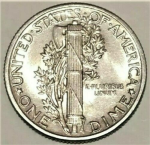Fasces: Difference between revisions
(Description) |
|||
| (46 intermediate revisions by 6 users not shown) | |||
| Line 1: | Line 1: | ||
The word fascism comes from '' | [[File:Etrusgasced.png|right|thumb|250px|The oldest known fasces was Etruscan, pre-Rome, and featured twin ards (plough blades)]] | ||
The word [[fascism ]]comes from ''fasci,'' the [[Latin]] word for ''hold'', (as in fascinate, fasten) which in this case represents a [[society]] of [[people]] united around a common [[ideal]]. In Latin the word "fasciculus" means "bundle". Its origins go back to the ancient Etruscans, long before the existence of [[Rome]], where it symbolized a unified Society. Later in Rome it became the [[symbol]] of a magistrate's (Judge's) office, and represented [[Justice]]. The ''fasces'' is a bundle of reeds with a tool that represents the focus of society, a tool that can also be used as a weapon such as a [[labrys]]<ref>Labrys symbol, its [[meaning]], [[history]], and origins - https://mythologian.net/labrys-symbol-meaning-history-and-origins</ref>, pick or an axe. In Rome, carried by magistrate attendants called lictors. | |||
=Anti-Roman propaganda= | |||
[[File:B625b6b39cbe8a9e.png|frameless|left|150px|]] | |||
The [[idea]] of the fasces as some sort of "punishment kit" is [[jews|jewish]] [[propaganda]] spread after the [[jews]] were ejected from Rome. <ref>Bloom, J.J. 2010 The [[jewish]] Revolts Against Rome, A.D. 66–135: A Military Analysis. McFarland.</ref> Similarly, it is highly unlikely that the lictors disassembled their standard of office, to use the reeds, sometimes decorated in gold, to flog criminals. <ref>[[Greek]] and [[Roman]] texts and facing English translation: Harvard University Press, 1914 thru 1927.Online in LacusCurtius and Livius.org. Book scan in [[Internet Archive]].</ref> The lictors carried with them an assortment of whips, scourges, and actual weapons like swords. The idea that the symbol of office was undone, used to brutalize people, or even kill them, is quite ridiculous. The [[parts of a fasces]] had a deep [[spiritual]] meaning to the [[Ancient Rome|Ancient Romans]], and probably the Etruscans before them. | |||
{{Quote|Fascism, in short, is not only a law-giver and a founder of institutions, but an educator and a promoter of spiritual life. It aims at refashioning not only the forms of life but their content - man, his character, and his faith. To achieve this propose it enforces discipline and uses authority, entering into the soul and ruling with undisputed sway. Therefore it has chosen as its emblem the Lictor’s rods, the symbol of unity, strength, and justice. “|Giovanni Gentile|The Doctrine of Fascism}} | |||
Fasces (English: /ˈfæsiːz/ FASS-eez; Latin: [ˈfaskeːs]; a plurale tantum, from the Latin word fasci. The [[principle]] represented by the Fasces is Strength through Unity. | |||
[[Category:History]] | |||
=See also= | |||
* [[Parts of a fasces]] | |||
* [[Fascism]] | |||
[[Category:History]] | |||
=References= | |||
{{Reflist|2}} | |||
[[Category:History]] | |||
Latest revision as of 17:12, 18 April 2024
The word fascism comes from fasci, the Latin word for hold, (as in fascinate, fasten) which in this case represents a society of people united around a common ideal. In Latin the word "fasciculus" means "bundle". Its origins go back to the ancient Etruscans, long before the existence of Rome, where it symbolized a unified Society. Later in Rome it became the symbol of a magistrate's (Judge's) office, and represented Justice. The fasces is a bundle of reeds with a tool that represents the focus of society, a tool that can also be used as a weapon such as a labrys[1], pick or an axe. In Rome, carried by magistrate attendants called lictors.
Anti-Roman propaganda
The idea of the fasces as some sort of "punishment kit" is jewish propaganda spread after the jews were ejected from Rome. [2] Similarly, it is highly unlikely that the lictors disassembled their standard of office, to use the reeds, sometimes decorated in gold, to flog criminals. [3] The lictors carried with them an assortment of whips, scourges, and actual weapons like swords. The idea that the symbol of office was undone, used to brutalize people, or even kill them, is quite ridiculous. The parts of a fasces had a deep spiritual meaning to the Ancient Romans, and probably the Etruscans before them.
Fascism, in short, is not only a law-giver and a founder of institutions, but an educator and a promoter of spiritual life. It aims at refashioning not only the forms of life but their content - man, his character, and his faith. To achieve this propose it enforces discipline and uses authority, entering into the soul and ruling with undisputed sway. Therefore it has chosen as its emblem the Lictor’s rods, the symbol of unity, strength, and justice. “
—Giovanni Gentile, The Doctrine of Fascism
Fasces (English: /ˈfæsiːz/ FASS-eez; Latin: [ˈfaskeːs]; a plurale tantum, from the Latin word fasci. The principle represented by the Fasces is Strength through Unity.
See also
References
- ↑ Labrys symbol, its meaning, history, and origins - https://mythologian.net/labrys-symbol-meaning-history-and-origins
- ↑ Bloom, J.J. 2010 The jewish Revolts Against Rome, A.D. 66–135: A Military Analysis. McFarland.
- ↑ Greek and Roman texts and facing English translation: Harvard University Press, 1914 thru 1927.Online in LacusCurtius and Livius.org. Book scan in Internet Archive.

